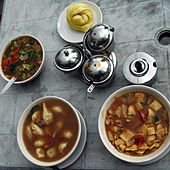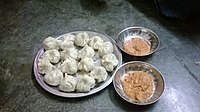Momo (food): Difference between revisions
Adding another category to it. |
Bhusan Aryal (talk | contribs) mNo edit summary Tags: Reverted Visual edit |
||
| Line 9: | Line 9: | ||
| alternate_name = |
| alternate_name = |
||
| country = [[East Asia]] and [[South Asia]] |
| country = [[East Asia]] and [[South Asia]] |
||
| region = [[Tibetan cuisine|Tibet]], [[Ladakh#Cuisine|Ladakh]], [[Northeast_India#Cuisines|Northeast India]],<ref name="Seow2017"/> and [[Darjeeling#Cuisine|Darjeeling]]<ref name="Seow2017"/> |
| region = [[Nepali cuisine|Nepal]], [[Tibetan cuisine|Tibet]], [[Ladakh#Cuisine|Ladakh]], [[Northeast_India#Cuisines|Northeast India]],<ref name="Seow2017"/> and [[Darjeeling#Cuisine|Darjeeling]]<ref name="Seow2017"/> |
||
| national_cuisine = [[Nepali cuisine|Nepal]], [[Indian cuisine|India]],<ref name="Seow2017"/> [[Bhutanese cuisine|Bhutan]] |
| national_cuisine = [[Nepali cuisine|Nepal]], [[Indian cuisine|India]],<ref name="Seow2017"/> [[Bhutanese cuisine|Bhutan]] |
||
| creator = [[Tibetan people]] or [[Lhasa Newar (trans-Himalayan traders)|Himalayan Newar merchants]] |
| creator = [[Tibetan people]] or [[Lhasa Newar (trans-Himalayan traders)|Himalayan Newar merchants]] |
||
Revision as of 11:03, 10 October 2020
This article needs additional citations for verification. (June 2017) |
 A typical serving of a plate of momo with sesame yellow and red garlic chilli sauce | |
| Course | Appetizers or entrees |
|---|---|
| Place of origin | East Asia and South Asia |
| Region or state | Nepal, Tibet, Ladakh, Northeast India,[1] and Darjeeling[1] |
| Associated cuisine | Nepal, India,[1] Bhutan |
| Created by | Tibetan people or Himalayan Newar merchants |
| Main ingredients | White-flour-and-water dough; meat, vegetable or cheese filling served with tomato and sesame chutney dip, tomato soup, soybean and sesame soup. |
| Variations | Steam-momo, Kothey momo, C-momo, Fry-momo, Open-momo, fried momo |
| 350 to 1000 (35 to 100 per piece) kcal | |
Momo is a type of East and South Asian steamed filled dumpling, popular across the Indian subcontinent and the Himalayan regions of South Asia.[1] Momos are native to Southwest Chinese region of Tibet, Bhutan, Nepal, North Indian region of Ladakh,[1] Northeast Indian regions of Sikkim, Assam, and Arunachal Pradesh,[1] and East Indian region of Darjeeling.[1] It is similar to Chinese baozi, jiaozi, and mantou, Mongolian buuz, Japanese gyoza, Korean mandu and Turkic manti, but heavily influenced by cuisine of the Indian subcontinent with Indian spices and herbs. Momos are extremely popular among the natives of the Indian subcontinent, and can be found in every kind of shop from restaurants to street vendors.[1]
Names
In Shanxi, where Jin Chinese is spoken, unfilled buns are often called momo (饃饃), which is simply the character for "steamed bun". The name momo spread to Tibet, India and Nepal and usually now refers to filled buns or dumplings.[2] Momo is the colloquial form of the Tibetan word "mog mog".[3] The different names for the dumpling include Assamese: মম; Bengali: মোমো; Nepali: मम; Nepal Bhasa: ममचा, मम:; Tibetan: མོག་མོག་, Wylie: mog mog; simplified Chinese: 馍馍; traditional Chinese: 饃饃; pinyin: mómo.[4]
History
The exact origins are unclear, but the name's etymology points to northern China (饃饃). The food is thought to have been spread by caravan routes connecting the Central Asian steppe to both East and West. Momo-like filled dumplings, called by a closely associated group of words, exist in Mongolian, Turkish, Persian, Uzbek, and many other Central and East Asian cuisines.[5] (For more, see entries on Mantou, Manti, and Buuz.)
As for the Himalayan momo, the dish is believed to have spread from Tibet along with the influx of the Tibetan diaspora. Since this dish was initially popular among the Newar community of the Kathmandu Valley of Nepal, one prevalent belief[6] is that traveling Newar merchants brought the recipe and the name momo from Tibet where the Newar Merchants used to go to trade. Originally, the filling of the dish was typically meat, such as yak, due to the scarcity of vegetables in Tibet. However, after arriving in North Indian plains, the momo was made vegetarian in the modern era to feed the large population of vegetarian Hindus.[1]
Description
Momo is a type of steamed dumpling with some form of filling. Momo has become a traditional delicacy in Nepal, Tibet, as well as among Nepalese and Tibetan communities in Bhutan, as well as people of Ladakh, Northeast India and Darjeeling regions of India.
Production


A simple white-flour-and-water dough is generally preferred to make the outer momo covering. Sometimes, a little yeast or baking soda is added to give a more doughy texture to the finished product.
Traditionally, momo is prepared with ground/minced meat filling, but in the modern era, this has changed and the fillings have become more elaborate. These days, momo is prepared with virtually any combination of ground meat, vegetables, tofu, paneer cheese, soft chhurpi (local hard cheese) and vegetable and meat combinations.[7]
- Meat: Different types of meat fillings are popular in different regions. In Nepal, Tibet, Darjeeling district, Sikkim and Bhutan, pork, chicken, goat meat and buffalo meat are commonly used. In the Himalayan region of Nepal, India, lamb and yak meat are more common. Minced meat is combined with any or all of the following: onions/shallots, garlic, ginger and cilantro/coriander. Some people also add finely puréed tomatoes and soy sauce.[8]
- Vegetables: Finely chopped cabbage, carrot, soy granules, potato, flat bean (Lilva Kachori) or chayote (iskush) are used as fillings in India and Nepal.
- Cheese: Usually fresh cheese (Paneer) or the traditional soft chhurpi is used. This variety is common in India and Eastern Nepal.
- Khoa: Momo filled with milk solids mixed with sugar are popular as dessert in the Kathmandu valley.
The dough is rolled into small circular flat pieces. The filling is then enclosed in the circular dough cover either in a round pocket or in a half-moon or crescent shape. People prefer meat that has a lot of fat because it produces flavorful juicy momos. A little oil is sometimes added to the lean ground/minced meat to keep the filling moist and juicy. The dumplings are then cooked by steaming over a soup (either a stock based on bones or vegetables) in a momo-making utensil called mucktoo. The dumplings may also be pan-fried or deep-fried after being steamed.
Varieties
There are typically two types of momo, steamed and fried. Momo is usually served with a dipping sauce (locally called chutney/achhar[9]), normally made with tomato as the base ingredient. Soup momo is a dish with steamed momo immersed in a meat or vegetable broth. Pan-fried momo is also known as kothey momo. Steamed momo served in hot sauce is called C-momo. There are also a variety of dumplings of Nepal found in the Indian state of Sikkim and Darjeeling district, including tingmo and thaipo.
Gallery
-
Momo in a mucktoo.
-
Kothey, a pan-fried momo variety.
-
C-momo
-
Indian-style Momos from Darjeeling, India with garlic chutney
See also
References
- ^ a b c d e f g h i Lynelle Seow (15 January 2017). CultureShock! India. Marshall Cavendish International Asia Pte Ltd. pp. 202–. ISBN 978-981-4771-98-6.
- ^ Gordon, Stewart (2009). When Asia Was the World: Traveling Merchants, Scholars, Warriors, and Monks Who Created the "Riches of the "East" (Reprint ed.). Da Capo Press. p. 13. ISBN 978-0306817397.
{{cite book}}: Cite has empty unknown parameter:|1=(help) - ^ Acta Orientalia Academiae Scientiarum Hungaricae. Akadémiai Kiadó. 1955. p. 209.
- ^ Jīn Péng 金鹏 (ed.): Zàngyǔ jiǎnzhì 藏语简志. Mínzú chūbǎnshè 民族出版社, Beijing 1983, p. 31. This is not the same as dumpling.
- ^ Gordon, Stewart (2009). When Asia Was the World: Traveling Merchants, Scholars, Warriors, and Monks Who Created the "Riches of the "East" ((Reprint ed.) ed.). Da Capo Press. p. 13. ISBN 978-0306817397.
- ^ Sijapati, Alisha (September 17, 2016). "A Juicy Love Affair". Retrieved September 22, 2016 – via The Kathmandu Post.
- ^ http://tasteofnepal.blogspot.com/2013/07/momos-or-dumplings.html
- ^ "Momo recipe". Himalayanlearning.org. Archived from the original on December 1, 2008. Retrieved April 6, 2011.
- ^ Williams, James. "Momos Chutney Recipe". ReciPickr.com.





